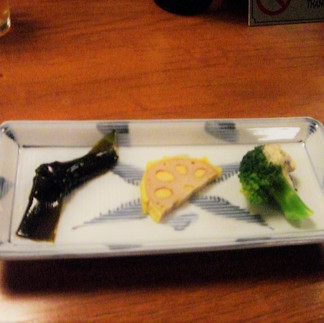The Gaijins, The Sashimi and The Sake
- Andre

- Dec 6, 2005
- 6 min read
Updated: Sep 16, 2020
Lisa attended an International Seminar (on Natural Ventilation) over 2 days in Tamachi (Tokyo). The last day was a Friday and I went along to explore the area. This being my first visit to Tokyo, naturally, I’m rather tentative to do anything adventurous. I kept circling the city blocks just to keep my bearings. There wasn’t much in terms of sightseeing or interesting shops even though I passed right by the Tokyo Tower.

At 333 meters, Tokyo Tower is a slight13 meters taller than its “model”, the Eiffel Tower of Paris, and at the time of writing the world's tallest self-supporting steel tower. It was completed in 1958 as a symbol for Japan's rebirth as a major economic power.
Visitors can go up to the main observatory at 150 meters and there is a special observatory at 250 meters to get a bird's eye view of Tokyo. We decided to give Tokyo Tower a skip because it’s well known to be rather cheesy. (Not to mention that they also charge an arm and leg to visit). Every time I hear a foreigner says: “But it looks just like the Eiffel Tower!” a nearby Tokyonite always responds with a quick” “But it’s taller!”
Had I known then what I know now (!), I would’ve hopped onto a train and visited nearby Roppongi Hills for a couple of hours. Nevertheless, as a first-timer, Tokyo was overwhelming. Regardless of whether you stroll through a quiet residential area, visit a gigantic department store or climb off the train in Shinjuku, you just cannot help but feel out of place.

The sheer level of energy is the most striking aspect of the city. It's true that the larger picture can be somewhat depressing - shoebox housing estates and office blocks traversed by overhead expressways crowded with traffic.
But this is the Japanese success story in action. The average Tokyo suburb hasn't yet fallen prey to supermarket culture and streets are still lined with tiny specialist shops and restaurants, most of which stay open late into the night.

We had lunch at a typical Japanese noodle shop. Oddly, most of the (traditional) Japanese style restaurants are only open for lunch from 11:00 to 1:30. They then re-open for dinner after 5 pm. We sat down just after 1 pm (still waiting for someone to join us) but proceeded to place some orders. Five minutes later our friend joined us – and we were promptly informed that the kitchen was already been closed for any further orders! Huh?
On to Shibuya.

When you meet someone at Shibuya, there is only one place to do so.
The statue of Hachiko the dog, (whose life is an interesting but sad story), seems to be the epicentre of what is the Shibuya Station exit. The sheer volume of people everywhere is absolutely incredible. Some just hanging around, having a smoke. Others seemingly hurried; scrambling to reach another destination.
Then you spot the intersection. Oh goodness.

Shibuya uses a four-way stop to allow pedestrians to inundate the entire intersection (this is called a "pedestrian scramble" or sukuranburu kōsaten).
I’ve heard that it is the world’s busiest pedestrian crossing and, after being there, I absolutely believe it. There’s nothing that can prepare you for it. In the 5 (or so) minutes of traffic passing through, people from all sides keep piling up. Just waiting for the light to change. The next second a wave sweeps across the road; threatening to wash you along with it if you're caught unawares.

Furthermore, the crossing has three large TV screens, which are on the buildings facing the crossing. The Starbucks store overlooking the crossing is reportedly the busiest in the world. The 2003 movie Lost in Translation featured a scene at the crossing (for those who didn’t fall asleep watching it). Shibuya is a crazy place. You don’t know where to look. There’s just too much happening. Sound and smells emanating from every angle. Bombarding your senses. Eventually, the only thing that remains is amazement.

We managed to make our way to a restaurant (?) recommended to us for excellent, authentic Japanese fare. I’m not really sure how we ended up where we did. It looks like an apartment building with a steep, winding staircase. All decidedly dodgy. On the 3rd floor, we went into a place the size of a postage stamp. There were only 3 tables in the place! One really big table with place for 10-12, and 2 other smaller ones (already occupied). We joined a Japanese couple already sitting at the big table.
They were pretty much into each other and didn’t seem to mind what we were doing. Actually a little creepy seeing this really old Japanese guy cuddling with a much younger, (fairly) good looking Japanese girl. (They left shortly after.)

Eventually, we ended up being quite a party. It was Lisa and me, Kawana-san, Andrea and Yoko (I think her name was), all students from TPU. We were joined by Mika, a friend of Andrea’s, who in turn, also brought 2 friends along. It was decided that we shall order a variety of dishes for the table so as to “introduce” the gaijins to some authentic Japanese cuisine. Great.
The “starter” was a little plate with 3 things on. Steamed seaweed, broccoli with some or other sauce, and an odd roundish slice of something that tasted like strong mustard. Sounds yummy, doesn’t it?
Next was “Natto”. We were advised to not smell it, but rather just eat it. Just what you want to hear about something you're about to taste for the first time.
It's made from fermented soybeans and stirring it produces lots of spiderweb-like strings. It was not our favourite dish.
We then got a selection of “sashimi” tuna and octopus. We were told by the people in the know that it was of particularly good quality. I found the tuna to be very nice – tastes like fillet steak. The octopus not. Lisa didn’t particularly enjoy either of the two.
We were pleasantly surprised with some pan-fried oysters served with steamed green beans. Very nice indeed.
All the while we’re washing everything down with Japanese beer that oddly tastes a bit like Windhoek Lager, and at some point, we switched to Sake. As luck would have it, a Japanese guy in a suit walked up to the table and introduced himself as the managing director of the company producing the particular Sake we were having. I’m not sure where he came from, but his Sake was very good. However, apparently Sake-induced hangovers are rather memorable and we were advised to be careful. It didn’t help much. Even with only one serving of Sake, Lisa suffered the repercussion of it the following day.
We were then served a Shabu-shabu type salad, consisting of thinly sliced pork with dressing, mixed with an assortment of lettuce. Very nice. Also very good was the chicken salad of which I don’t remember the name. It was Lisa’s favourite though.
The meal ended with some communal pots (nabe) from which we served ourselves some sliced beef and vegetables with a broth. Interesting.
You’re probably curious as to what this meal cost? Well, the interesting thing is that in Japan, bills are rarely itemised and never split. So the norm is for the final sum to be equally divided between all. It’s also not common practice that Japanese woman pays for themselves. But, with younger people in a group, the “rules” are a bit more flexible. The total bill came to a shade over Y30 000. All in all not too bad, considering you can expect to pay anything from Y2500-Y10 000 (a dish) in Tokyo.
Drinks are very expensive though. If you order a beer in a bar you would expect to pay between Y500 and Y800. Apparently there are some places where you pay a flat fee and then drink as much (beer) as you like.
But how much beer does one want to drink I hear you ask? It is said that drinking is the glue that holds Japanese society together. It is practised by almost every adult, male or female, and a good number of teenagers. Beer is the favourite of the Japanese and it's dispensed everywhere from vending machines to temple lodgings.
After leaving the restaurant we caught the last train back to Hon-Atsugi and were home around one-thirty. Quite a night.










